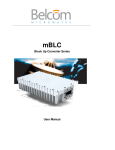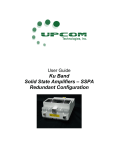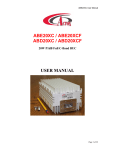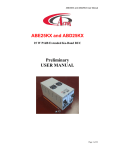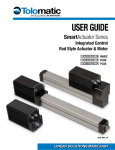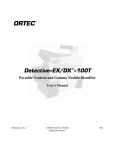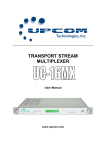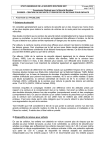Download upcom Y User guide
Transcript
UPCOM TECHNOLOGIES User Guide C Band BLOCK UP CONVERTERS Model Y 1 UPCOM TECHNOLOGIES Table of Contents Table of Contents.................................................................................................................................... 2 Outdoor Block Up-Converter - BUC ...................................................................................................... 3 User Guide .............................................................................................................................................. 3 Description.......................................................................................................................................... 3 Equipment Supplied............................................................................................................................ 3 General Information............................................................................................................................ 4 Safety Considerations ..................................................................................................................... 4 High Voltage Hazards..................................................................................................................... 4 RF Transmission Hazards ............................................................................................................... 4 Inspection........................................................................................................................................ 4 Return of Equipment....................................................................................................................... 4 Ports and Interfaces............................................................................................................................. 5 Prime Power Connection ................................................................................................................ 5 RF Input .......................................................................................................................................... 5 RF Output........................................................................................................................................ 6 M & C Connector............................................................................................................................ 6 Airflow............................................................................................................................................ 6 Monitors and Controls ........................................................................................................................ 7 Ground (GND) ................................................................................................................................ 9 RS-232 / RS-485 ............................................................................................................................. 9 Monitor and Control Software ........................................................................................................ 9 Quick Start Guide ............................................................................................................................. 11 General Maintenance ........................................................................................................................ 12 Basic Cleanliness .......................................................................................................................... 12 Internal Fuse.................................................................................................................................. 12 Fan Replacement........................................................................................................................... 12 Appendix A – UC 40C Series Y BUC.............................................................................................. 13 2 UPCOM TECHNOLOGIES Outdoor Block Up-Converter - BUC User Guide This section provides general information for the UPCOM TECHNOLOGIES line of C BAND Outdoor SSPA Based - BUCs. The Outdoor BUC Series Y has been designed and manufactured to be extremely robust and reliable. It is well suited for harsh outdoor environments. Description Please refer to Appendix A for the appropriate product data sheet and specifications. The Outdoor BUC Series Y is a one-piece integrated Block Up Converter and amplifier system. It includes the AC / DC Power Supply, L Band to C Band Up-Converter module, microwave Booster Amplifier Module, microcontroller based monitor (optional) and control circuitry, and an efficient thermal management system. The reduced size and weight of this system allow it to be used in a wide variety of installations; many of which historically precluded the use of solid state units. This system is ideal for mounting on the boom of small antennas or anywhere that size and weight are a major concern. Features include: Compact size Light weight Auto-Sensing Power Supply Output Power Detection Optional Internal 1:1 Redundant Capability Serial (RS-232 / RS-485) Monitor & Control Circuitry Windows Monitor & Control Software Optional gain control (on selected configurations) Equipment Supplied The following equipment is supplied with each unit: The Outdoor BUC Assembly Prime Power Mating Connector M & C Mating Connector (where applicable) CD with UPCOM TECHNOLOGIES Monitor & Control Software (where applicable) 3 UPCOM TECHNOLOGIES General Information Safety Considerations Potential safety hazards exist unless proper precautions are observed when working with this unit. To ensure safe operation, the user must follow the information, cautions, and warnings provided in this manual as well as the warning labels placed on the unit itself. High Voltage Hazards Only qualified service personnel should service the internal electronic circuitry of the Outdoor BUC. High DC voltages are present in the power supply section of the amplifier. Care must be taken when working with devices that operate at this high voltage levels. It is recommended to never work on the unit or supply prime AC power to the unit while the cover is removed. RF Transmission Hazards RF transmissions at high power levels may cause eyesight damage and skin burns. Prolonged exposure to high levels of RF energy has been linked to a variety of health issues. Please use the following precautions with high levels of RF power. Always terminate the RF input and output connector prior to applying prime AC input power. Never look directly into the RF output waveguide. Maintain a suitable distance from the source of the transmission such that the power density is below recommended guidelines in ANSI/IEEE C95.1. The power density specified in ANSI/IEEE C95.1-1992 is 10 mW/cm². These requirements adhere to OSHA Standard 1910.97. When a safe distance is not practical, RF shielding should be used to achieve the recommended power density levels. Inspection When the unit is received, an initial inspection should be completed. First ensure that the shipping container is not damaged. If it is, have a representative from the shipping company present when the container is opened. Perform a visual inspection of the Outdoor Amplifier to make sure that all items on the packing list are enclosed. If any damage has occurred or if items are missing, contact: UPCOM TECHNOLOGIES Inc. Return of Equipment When returning items back to UPCOM TECHNOLOGIES for replacement or repair, please prepare the following information: A written description of the problem encountered. The part number and serial number of the unit in question. Once this information is ready, please contact UPCOM TECHNOLOGIES for a Return Material Authorization (RMA) number and shipping instructions. 4 UPCOM TECHNOLOGIES Ports and Interfaces Prime Power Connection The Prime Power Connector is the point where the unit receives input power. The AC input can operate over a range of 90 - 260 VAC, at 47 - 63 Hz. This connector is a 3 (three) pin circular connector 3100A 14S-7P and the mating connector is supplied with the unit Pin A-C B Circuit 110/220V (90-260V) AC Ground It’s recommended that the BUC should be powered from a 180 - 260 VAC source. This will keep AC line currents to a safe operating level and minimizes cable losses. In some cases, the unit may only be specified to operate at higher input voltage levels – please check the labels or accompanying Test Record for this information. When wiring up the mating connector, carefully follow the pin descriptions noted in the accompanying Test Record. Incorrect connections can seriously damage the unit. It is highly advisable that the installer checks all the pins at the AC connectors for resistance to the chassis ground to make sure that the live and ground pins are correctly identified . Please contact the factory if there are any questions regarding these input connections. RF Input The RF Input is an N type connector. The input frequency is L Band. Nominal RF input levels are -50 to 0 dBm, depending on the output power level and the system gain of the unit. The maximum input level should be limited to 0 dBm to avoid damaging the unit. Attention: This BUC Series Y does not require DC Voltages at the L Band Input Port. DO NOT INPUT DC VOLTAGES! 10MHz Reference is required at the L Band Input . 5 UPCOM TECHNOLOGIES RF Output The RF Output is provided at a waveguide flange in the Outdoor BUCs. The C Band BUCs have CPR style grooved flange (CPR-137G). An isolator is provided at the output flange with a termination capable of handling full reflected output power. Caution should be observed here to make sure that the antenna or a suitable termination (dummy load) is connected to this port before operating the BUC. The BUC is protected against reflection but dangerous levels of microwave energy can be present at this port. The output of the BUC should be connected to the antenna feed by means of flexible or rigid waveguides. The use of coaxial cables and adapters is not recommended and it will void the equipment warranty . Never look directly into the RF output waveguide. M & C Connector The Monitor and Control (M & C) connector is the primary interface point for controlling the BUC and monitoring fault conditions. It also provides control to a waveguide switch in Redundant configurations A Redundant configured unit may be operated in stand-alone mode, and behaves in a similar way to a normal Microcontroller equipped unit. If this is done, it is important to cover the Redundancy Port to protect it from the external environment, since there are live voltages present on this interface. Never connect anything except for the supplied cables to this interface port. Airflow The air intake and exhaust are both located on the bottom side of the BUC. The intake is brought through one or two fans ( two fans on 50 watts units KU Band and higher and one fan on lower power units) while the exhaust is along the rows of heat-sink fins. A minimum clearance of 12 inches (305 mm) should be maintained between the air intake of the Outdoor BUC and exhaust during operation. This will ensure that there is no forced recirculation of airflow from exhaust to intake. Some lower output power units are not equipped with a fan, but the same clearance stated above must be kept around the unit for proper operation. 6 UPCOM TECHNOLOGIES Monitors and Controls Monitor signals and Control lines are present on the M & C Connector when this option is installed. With a Microcontroller equipped system, all Monitors and Controls can also be accessed remotely by RS-232 / RS-485 to a Windows based PC; and other Alarms become available as well. Units equipped with a Redundancy option have a Microcontroller M & C installed by default. The full M & C Connector pin-out is listed here for convenience. However, always check the Test Bench Record supplied with the unit to view which interfaces have been installed on your unit, or to see if it has had any custom modifications. 7 UPCOM TECHNOLOGIES Connectors Pin-out J4 M&C connector 10pin PT02 E12-10P RS 485 A Rx+ B RxC Tx+ D Tx- RS 232 J Rx K Tx G GND COM port setting: 9600 bps, 8 bit, 1 stop bit J5 Redundancy SWOV connector 10pin PT02 E12-10P A SW COMMAND 1 F SW POS 2 B COMMON G ALARM OUT C SW COMMAND 2 H ALARM IN D SW POS 1 J MODE OUT E COMMON POS K MODE IN Connector Name J1 “IF IN” J2 “RF OUT” J3 “AC POWER IN” J4 “M&C Interface” J5 General Connectors Pin Assignment Pin # Signal Remarks RF Input 33 dBm, max WR-75 N/A BUC OUT WR-75 N/A RF Output 47.0 dBm max A Line (AC) 97-3100A-14S-7P 110/220VAC B Ground 3 pin male 90-260V C Neutral (AC) A Rx+ In B Rx- In RS-485 C Tx+ Out D Tx- Out E Detector Optional PT02E12-10P-027 F Alarm Out Low when alarm 10 pin male G GND H Mute In Muted when Low J Rx In RS-232 K Tx Out Type LED N/A 8 Green – normal Green blinking – mute Red – alarm UPCOM TECHNOLOGIES Ground (GND) This pin is connected to the chassis, which also represents the main Ground of the unit. The installation of the BUC at the antenna and the signal and AC cables running from the BUC to the building should be properly grounded to avoid power surges that may damage the equipment. All antennas shall be grounded locally. All cable entries at the building shall be grounded at building entry. Cable entry ground shall be connected to building ground by AWG#4 copper wire. Cable entry ground shall be connected to antenna ground by AWG#4 copper wire. PLEASE MAKE SURE THAT THE UNIT AND CABLES ARE PROPERLY GROUNDED TO AVOID DAMAGES TO THE EQUIPMENT AND RISK TO PERSONEL ! – DAMAGES DUE TO POWER SURGES WILL VOID THE WARRANTY! RS-232 / RS-485 This serial link is normally used to communicate with a remote PC running UPCOM TECHNOLOGIES Monitor and Control Software. This enables a simple way to view / control the Monitors and Controls listed above, and also enables the functions listed below. Normally, either RS-232 or RS-485 is available at any one time (both interfaces cannot be used simultaneously). Communication links using RS-232 are typically good up to 30 ft. (9 m) in length. Installations exceeding this length should use the RS-485, which will allow serial control up to 4000 ft. (1200 m). Monitor and Control Software UPCOM TECHNOLOGIES Monitor and Control Software is provided on CD for units equipped with an onboard Microcontroller system. A Windows based PC uses this software to remotely monitor and control the BUC through its serial port. Various Monitors and Alarms are displayed along the left hand side of the interface. If a problem has been detected, it will be displayed in red, and the Block Up Converters (BUC) will be placed into a muted state. Installation Instructions System Requirements: PC running Windows 98, Me, 2000, or XP (NT 4.0 with Service Pack 6a) Display resolution of 800 x 600 or greater Free serial port (RS-232 or RS-485) Microsoft .NET Framework. Compatibility under Windows Vista has not been tested. 9 UPCOM TECHNOLOGIES Status Display This indicator shows the general status of the Outdoor BUC – if everything is good, or if an error condition has occurred, or if the unit has been manually disabled by mute control. Also, the operating status of a Master/Slave redundant pair is reflected. Temperature Display Using the UPCOM TECHNOLOGIES Monitor and Control Software, a thermometer display with a numeric readout of the base-plate temperature of the unit in degrees Celsius is shown. The base-plate temperature typically experiences a 20 to 30 degree rise above ambient on the highest power Outdoor BUCs and 15 to 20 degree rise on lower power units. This display corresponds with the Temperature Monitor outlined in the analog M&C section above. Output Power Display A numeric readout of the output power level is displayed in units of dBm. The indicator is calibrated at the factory using the middle frequency of the BUC, and has approximately a 20 dB dynamic range. When this range is exceeded, the readout shows “Low” or “High” depending on which particular limit has been reached. PS Voltages Monitor The output voltage levels of the Power Supply are monitored and this alarm indicates when any of them fall below a preset level. The unit will enter a muted state when this alarm is active. Manual Control Enable/Disable and Mute Input A manual mute control can be accessed from the Enable/Disable button of the software. For systems set up for 1:1 Redundant operation, this control is also used for manually selecting the Active unit in a redundant pair. Communication Status The communication status between the software and the BUC is reflected here. If there is a problem here, double-check all serial port connections and ensure the correct Com port is selected (the software uses the Select Port menu item). 10 UPCOM TECHNOLOGIES Quick Start Guide Connect the low power L Band output from a modulator or a 10MHz Insertion Box to the BUC Input port. Nominal input levels are approximately -50 to 0 dBm depending on the output power level of the unit. DO NOT FEED DC VOLTAGES TO THE L BAND INPUT The BUC’s output is taken from the waveguide port (RF Out). Caution should be observed here to make sure that the antenna or a suitable termination is connected to this port before operating the BUC. Ensure there is proper clearance around the unit. Connect the chassis ground to a proper ground connection Connect AC Input power to the connector. The unit will be enabled almost immediately, provided it is not forced into a mute state. Optional - Connect the M & C interface to an available COM port on your computer and/or to your analog based monitoring and control equipment. Optional - Run the UPCOM TECHNOLOGIES Monitor and Control Program. Recommendation: if possible install the BUC with the fans facing down in order to avoid accumulation of debris inside the fans that may block the fans. 11 UPCOM TECHNOLOGIES General Maintenance With proper care and maintenance, your BUC will provide many years of reliable service. Please follow these maintenance guidelines so that your equipment will provide you with the maximum amount of trouble-free service. Basic Cleanliness The exterior chassis of the BUC acts as a large heatsink that must dissipate at least a few hundred Watts. Excessive dirt, dust, debris, and sand accumulated on the chassis surface will impede its ability to dissipate heat, and will result in higher internal temperatures, potentially shortening the BUC lifespan. Periodically inspect the chassis for excessive dirt, and remove as necessary. A brush combined with compressed air is the safest way to clean the unit. Also, inspect the fan assembly for any dirt or debris that also might impede airflow. Internal Fuse The internal power supply is protected by a fuse to prevent excessive input current consumption. Contact the factory if you suspect the internal fuse has tripped, and instructions will be sent on how it can be replaced. Fan Replacement Normally the fan on the unit operates continuously when input power is connected to the unit. If the fan stops turning, and the BUC still provides an output signal when it is cool, it is time to replace the fan. Immediately remove power to the unit the prevent damage by overheating. Contact the factory to order the correct replacement fan for your particular model. The fan is encased in a shroud to direct airflow to the chassis heatsink fins. First remove the shroud from the main chassis using the screws at each side of the chassis. The fan and shroud assembly will be connected by wires to the main chassis. Disconnect the wire connection by pulling apart the inline (wire to wire) connector. Next, remove the screws holding the fan to the shroud and fan grille. Remove the fan, and install the replacement fan in reverse order as described above. 12 UPCOM TECHNOLOGIES Appendix A – UC 40C Series Y BUC Input Frequency Range Operating Frequency Range Output Power Input Power @ P1dB output Input Power range without damage Input Return Loss 950 – 1700 MHz 5.85 – 6.60 GHz 46 dBm ( 40 watts ) - 20 dBm nominal 0 dBm MAX > -16 dB Gain Gain flatness I/O VSWR Gain flatness 40MHz Gain Variation Over Temperature Spurious @ P1dB IMD (With 2 carriers @6dB backoff 1dB Comp) 65 dB min 2.0 max -15 dB 0.3 dB 3 dB max -55dBc max -27dBc max Power supply AC 220V ±20%, 50/60Hz Operating Temperature Relative Humidity Weight ( 40 watts C ) Dimensions ( 40 watts C) -40 °C to 55 °C up to 98% 5 kg 257x140x95mm Phase Noise < -30 dBc/Hz at 10 Hz < -60 dBc/Hz at 100 Hz < -70 dBc/Hz at 1 kHz < -80 dBc/Hz at 10 kHz < -90 dBc/Hz > 100 kHz 10MHz Sine wave - 5 to +5 dBm External Reference Required Reference Input Level 13













